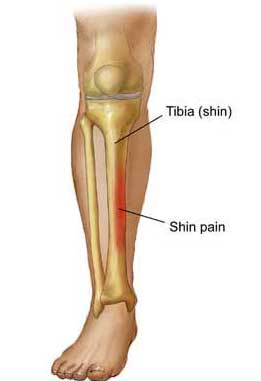
Shin Splints
 Shin splints, known as medial tibial stress syndrome (MTSS). Pain in the shins - the front lower leg. Shin splints seem is an inflammation due to injury of the tendon (posterior peroneal tendon) and adjacent tissues in the front of the outer leg.
Shin splints, known as medial tibial stress syndrome (MTSS). Pain in the shins - the front lower leg. Shin splints seem is an inflammation due to injury of the tendon (posterior peroneal tendon) and adjacent tissues in the front of the outer leg.
Cause -
• Exerting excessive pressure on the lower leg muscles
• Excessive impact on the muscle
• Stop-start sports such as squash, tennis or basketball
• Running too much on hard surfaces is also a common cause of shin splints.
• A serious mistake is to try to "run through the pain" if it is a shin pain .There is injury to the bone and surrounding tissue.
• Running downhill
• Running on a slanted surfaces or uneven terrain
• Running with inappropriate shoes
• Stress fractures, which are tiny breaks in the lower leg bones
• Over pronation or ''flat feet" -- when the impact of a step makes your foot's arch collapse
Symptoms -
• Pain
• Dizziness
• Fatigue
• Anxiety
• Pain along the inner part of the lower leg. An area of discomfort measuring 4-6 inches (10-15 cm) in length is frequently present.
• Tenderness or soreness along the inner part of the lower leg
• Moderate swelling in the lower leg.
• Feet may feel numb and weak, because swollen muscles irritate the nerves
Investigation -
x-ray, MRI ,CT Scan
Physiotherapy -
1. Rest your body:- It needs time to heal.
2. Ice your shin:- to ease pain and swelling. Do it for 20-30 minutes every 3 to 4 hours for 2 to 3 days, or until the pain is gone.
3. Anti-inflammatory painkillers.
4. Arch supports for your shoes:- This orthotics -- which can be custom-made or bought off the shelf -- may help with flat feet.
5. Range-of-motion exercises
6. Neoprene sleeve:- to support and warm your leg.
7. Exercise:- to strengthen the muscles in your shins.
shin splints are fully healed when:
1. Your injured leg is as flexible as your other leg.
2. Your injured leg feels as strong as your other leg.
3. You can jog, sprint, and jump without pain.
4. Your X-rays are normal or show any stress fractures have healed.
Prevention -
• Always wear shoes with good support and padding.
• Warm up before working out, stretch the muscles in your legs.
• Stop working out as soon as you feel pain in your shins.
• Don't run or play on hard surfaces like concrete.

